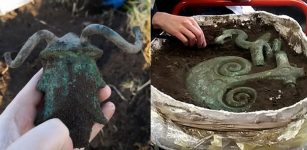Remains Of 1,600-Year-Old Roman City Of Neapolis Devastated By A Tsunami Discovered
AncientPages.com - Archaeologists have found a massive complex of underwater ruins off the northeastern coast of Tunisia, proving that an ancient Roman city that once stood there was devastated by a tsunami 1,600 years ago and was partially lost beneath the waves.
The discovery has revealed the Roman city of Neapolis, with its networks of submerged streets and monuments, was a crucial trading hub in ancient north Africa.
Columns from the Roman ruins are seen in Sbeitla, in Kasserine; Tunisia is home to some of the most impressive examples of Greek, Phoenician, Roman, Byzantine, Arab and European heritage sites. REUTERS/ZOHRA BENSEMRA
Neapolis, which means ‘new city’ in Greek, was founded in the fifth century B.C. by ancient Greek colonists. The city has changed hands several times over the ages, transferring to Carthaginian, Roman and then Arab rule.
They include the Carthaginian capital of Carthage. The ruins, characterized by their tall Phoenician pillars, are spread across a modern Tunisian city that shares the same name. It became a UNESCO world heritage site in 1979.
University of Sassari/AFP
The powerful tsunami that took place struck in Alexandria, the Greek Island of Crete and partly destroyed the city if Neapolis.
"It's a major discovery," Mounir Fantar, the head of a Tunisian-Italian archaeological mission which made the find, told AFP.
Scientists have been able to recover Roman food products, including roughly 100 tanks of fermented fish that was used as a condiment known as garum in the Roman empire.
"This discovery has allowed us to establish with certainty that Neapolis was a major center for the manufacture of garum and salt fish, probably the largest centre in the Roman world," said Fantar.
"Probably the notables of Neapolis owed their fortune to garum," he added.
AncientPages.com






















